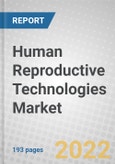Report Scope
The report is designed to be a comprehensive business tool to provide an in-depth look at the markets for reproductive drugs and technologies. The geographic scope of the report is global. The report reviews male and female reproductive health, presents standard pharmaceutical treatments and devices, and reviews technologies associated with reproductive health. The report also explores market size, identifies market participants, and investigates pipeline products and technologies.
The global market for reproductive technologies and products is divided into categories by treatment type and indication as follows.
Infertility market - male and female factors, pharmaceuticals, and future advancements.
- IVF.
- Assistive reproductive technologies.
- Fertility diagnostics.
Contraception - pharmaceuticals and devices. Sexual dysfunction - pharmaceuticals and devices.
Each area is covered in detail, describing the disorder or treatment involved, identifying current products and treatments in the market in the base year 2021, measuring current market size and identifying current and potential market drivers, forecasting for 2027, assessing current and potential competitors, and identifying current competitor market shares for the base year of 2021.
Report Includes
- 36 data tables and 22 additional tables
- An updated review of the global markets for human reproductive products and technologies
- Analyses of the global market trends, with data from 2020-2021, estimates for 2022, and projections of compound annual growth rates (CAGRs) through 2027
- Evaluation and forecast the overall market size, projected growth trends, and corresponding market share analysis by treatment type, disease indication, end-user vertical, and geographic region
- In-depth information (facts and figures) concerning market drivers, market deterrents and other demographic and economic factors influencing the progress of this reproductive health market
- Discussion of the emerging technology trends, opportunities and gaps in the market estimating current and future demand for reproductive drugs and technologies, and COVID-19 implications within the marketplace
- Identification of promising new products and technologies still in the development and pipeline stage, and assess the probability that they will be commercialized successfully in the next five years
- Review of the company competitive landscape for global human reproductive drugs market, their product portfolios, global rankings, and company value share analysis based on segmental revenues
- Key merger and acquisition deals, new product launches, and other strategic alliances within the industry
- A relevant patent analysis
- Descriptive company profiles of the leading global players, including Actavis,Inc., Bayer AG, EMD Serono,Inc. and Quidel Corp.
Table of Contents
Executive Summary
Many factors influence the human reproductive arena. Countries differ in their approaches and acceptance of fertility, contraception, and sexual dysfunction. Culture, religion, and social environment all play a role; depending on the country and position of women in the society, it can make a huge difference on how reproduction is treated. The choice of contraception varies by country: in Japan, condoms and abortions are preferred to other methods; in India, sterilization is the preferred method of birth control; in China, the use of the coil is preferred; while in Africa, injectable birth control dominates. This difference in preference by country is also seen in the fertility and sexual dysfunction areas.
There have been increasing investments and advancements in each of the three major areas of infertility, contraception, and sexual dysfunction.
One of the most widely publicized, celebrated and, at the time, controversial medical landmarks in this area is the use of assisted reproductive technology (ART) to manage infertility. Recent developments in the field of ART have intensified the hopes and the wishes of infertile people to resolve their infertility, resulting in an increasing demand for such services in both developed and developing countries. While developments in ART have evolved rapidly, so have the ethical, social, and political controversies that surround nearly all aspects of ART. Few other areas in medicine have posed so many social and ethical questions and attracted so much public attention. Cultural differences influence the acceptance of ART.
In addition, economic forces play a role in this market because it is an expensive undertaking that is not affordable to many. In Asia, the doors seem to be opening for growth, but there are barriers to overcome such as educating physicians and patients about the procedures and social and culture mores that influence ART.
New developments in the area of contraception have stepped up the quest for easier, safer, and more convenient methods of contraception. There is no miracle drug or method of contraception, but scientists are pursuing several avenues of discovery to create better options for individuals.
Sexual dysfunction is now an acknowledged disorder by the general public and the medical community. Prior to the advent of Viagra, the disorder was present but not acknowledged and largely went untreated. The introduction of Viagra opened Pandora’s box in the development of sexual dysfunction drugs and devices for both sexes, at a time when female sexual dysfunction was virtually unknown. This area of reproductive health is teeming with opportunities for research and discovery and will likely continue to advance over the next few years, but progress has been slow, and some ED products are open to generic development.
Companies Mentioned
- Actavis, Inc.
- Bayer AG
- Bristol-Myers Squibb Co.
- Church & Dwight Company Inc.
- Coopersurgical Inc.
- Eli Lilly & Co.
- Emd Serono, Inc.
- Ferring Pharmaceuticals
- GlaxoSmithKline plc
- Janssen Pharmaceutical
- Merck Inc.
- Novartis International AG
- Pfizer Inc.
- Princeton Biomeditech Corp.
- Quidel Corp.
- Teva Pharmaceuticals.
- Vivus Inc.
- Selected List of U.S. Fertility Clinics
- List of Companies
Table Information
| Report Attribute | Details |
|---|---|
| No. of Pages | 193 |
| Published | July 2022 |
| Forecast Period | 2022 - 2027 |
| Estimated Market Value ( USD | $ 17.1 Billion |
| Forecasted Market Value ( USD | $ 24 Billion |
| Compound Annual Growth Rate | 7.0% |
| Regions Covered | Global |
| No. of Companies Mentioned | 19 |









